Over more than 100 years, Gränsfors Bruks AB has built up a business based around handcrafted axes and axe expertise, with a focus on quality and environmental responsibility.
Today, 30 people work here in production and sales. 80 percent of the production is exported to 30 countries.
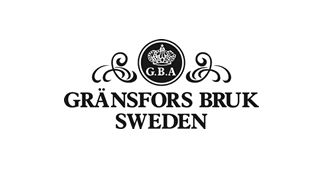
When it comes to the quality and feel of the axes, much depends on the experience and skill of the individual craftsman. Each axe is signed with the smith’s initials as a guarantee of quality.
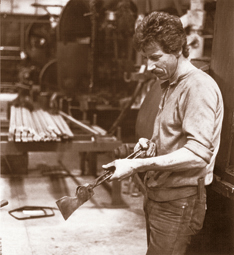
The company is located in the Swedish village of Gränsfors in northern Hälsingland, around 10 km west of the E4 motorway, between Hudiksvall and Sundsvall. The forge sits at the heart of the village and you can hear the rhythmic pounding as you approach. In addition to the forge and a factory shop, there is also an axe museum and during the summer a restaurant, café and craft courses in subjects such as forging and log-building.
THE TIME BEFORE GRÄNSFORS BRUKS AB (1868 – 1902)
The first concrete evidence we have about an axe forge in Gränsfors dates from the mid-19th century. In 1868, scythe smith Johan Pettersson (JP), aged 33, moved with his family and his brother Anders Pettersson (AP), aged 18, from Älvdalen to Gränsfors and set up Gränsfors Scythe Forge. Johan Pettersson probably also made axes in his scythe forge, which he ran until 1900. In 1871, younger brother Anders Pettersson bought another scythe forge in Gränsfors, which in 1902 formed the basis for Gränsfors Bruk’s Axe Forge. Anders also forged both scythes and axes.
The latter part of the 19th century marked the start of large-scale logging operations in northern Sweden and demand for forest tools, above all axes, exploded. Around 400,000 people worked full- or part-time in the forest at the peak of the logging.
By the end of the 19th century there were around ten axe factories in Sweden turning out large quantities of axes. The most well known axe forges, from the south of the country upwards, were in Forserum, Kölefors, Åby, Arvika, Säter, Storvik, Gävle and Edsbyn. Although axe exports were high from an early stage, the biggest demand remained up north, which is how the idea came about to build a new axe forge north of the existing ones. The chosen location was of course Gränsfors.

FORMATION OF GRÄNSFORS BRUKS AB (1902)
1902 saw Anders Pettersson form the limited company Gränsfors Bruk, which took over the forge in Gränsfors.
The term ‘bruk’ (works) was used historically to describe large industrial companies, e.g. ‘bergsbruk’ (mining works) and ‘järnbruk’ (ironworks). Both these activities were governed by Royal privileges. Mining companies had the privilege and duty to mine iron ore and make pig iron, but only the ironworks had the right to turn the pig iron into bar iron – the base material for making iron products.
The word ‘bruk’ is also used for other factories, such as ‘glasbruk’ (glassworks) and ‘pappersbruk’ (papermill).
The works and mills were largely self-sufficient communities, with most of what was needed for production and survival produced locally. Farming and forestry were integrated into the operation, as were food and lodgings for employees. The location of many works and mills was largely determined by access to energy from nearby rivers.
All Royal privileges were abolished in 1859, opening up the industries to freer competition. The old industrial operations were often turned into limited companies. Some removed the word ‘bruk’ from their name, but retained their status as the dominant workplace and powerhouse in their area.
The work ‘Bruk’ in Gränsfors Bruk’s company name may have been a way to make the company seem bigger and more historic than it actually was. Gränsfors Bruk certainly did not emerge from the old industrial works with their Royal privileges, but this fact probably remained unknown to its customers, who were often based a long way down south in Sweden and had never set foot anywhere near Gränsfors.
Anders Pettersson headed the new company from 1902-1908. Alfred Wennerström came to Gränsfors at that time, having worked at other axe forges in Sweden, as did smith Oskar Rising, who had worked at the forge in Pinjainen, Finland (now Fiskars). In 1907, there were 10 people working at Gränsfors Bruk. After Anders Pettersson, banker A. Lundberg was head of Gränsfors Bruk for a few years.
THE ERIKSSON FAMILY (1917 – 1982)
Olof Eriksson moved from Kall in Jämtland to Bergsjö aged 25 and set up a hardware store under the name O. Eriksson Järnaffär. In addition to his retail operation, he also traded in goods that he commissioned, mostly from local producers. These included scythes, axes, forestry tools and other items that generally went under the name of ironmongery. A highly enterprising man, Olof Eriksson was involved in starting up several companies in the area. In 1917, Eriksson took over Gränsfors Bruk and became its managing director. After 1917, axe production rose sharply with the purchase of a new ‘Arboga 35’ forging press, partially funded by Eriksson the ironmonger. The press cost SEK 17,000 back then, and is still used to this day at Gränsfors Bruk to forge the Gränsfors Outdoor Axe and the Gränsfors Mini Hatchet.
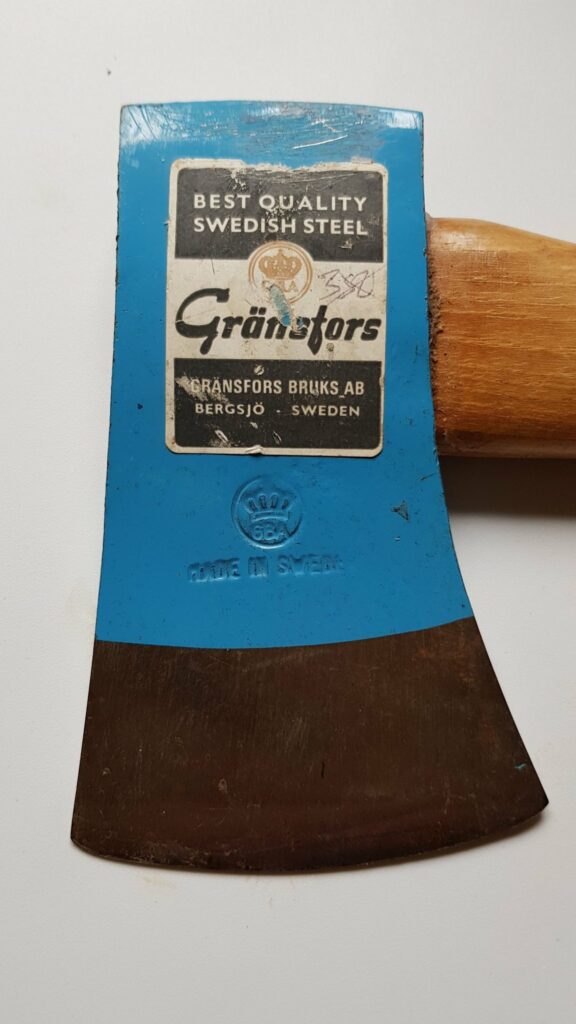
FOCUS ON EXPORTS (1920 – 1960)
In 1920, axe production almost came to a standstill. For a brief time, only the brothers Birger and Axel Wennerström were working at Gränsfors Bruk. In the 1920s, Olof Eriksson contacted the Russian Embassy in Stockholm, prompting the launch of exports to Russia. The list of export markets later expanded hugely, key amongst them being South America and Canada. The export countries also included the USA, New Guinea, Australia, New Zealand, Finland and Latvia. Production was low during the Great Depression of the 1930s, but soon took off again.
In the 1940s and 1950s, Axel Bäckström was in charge, with Axel Wennerström heading up production. Despite Swedish being the only language that they and everyone else at Gränsfors Bruk spoke, during this period the company successfully exported primarily to the USA, Argentina and Colombia. During and after the Second World War, business remained good and Gränsfors Bruk celebrated its 50th anniversary in 1952 in fine form. That year the workforce of 40 men produced nearly 200,000 axe heads. Twelve of these men, who had worked at the forge for 25 years or more, were awarded medals for their long and faithful service.
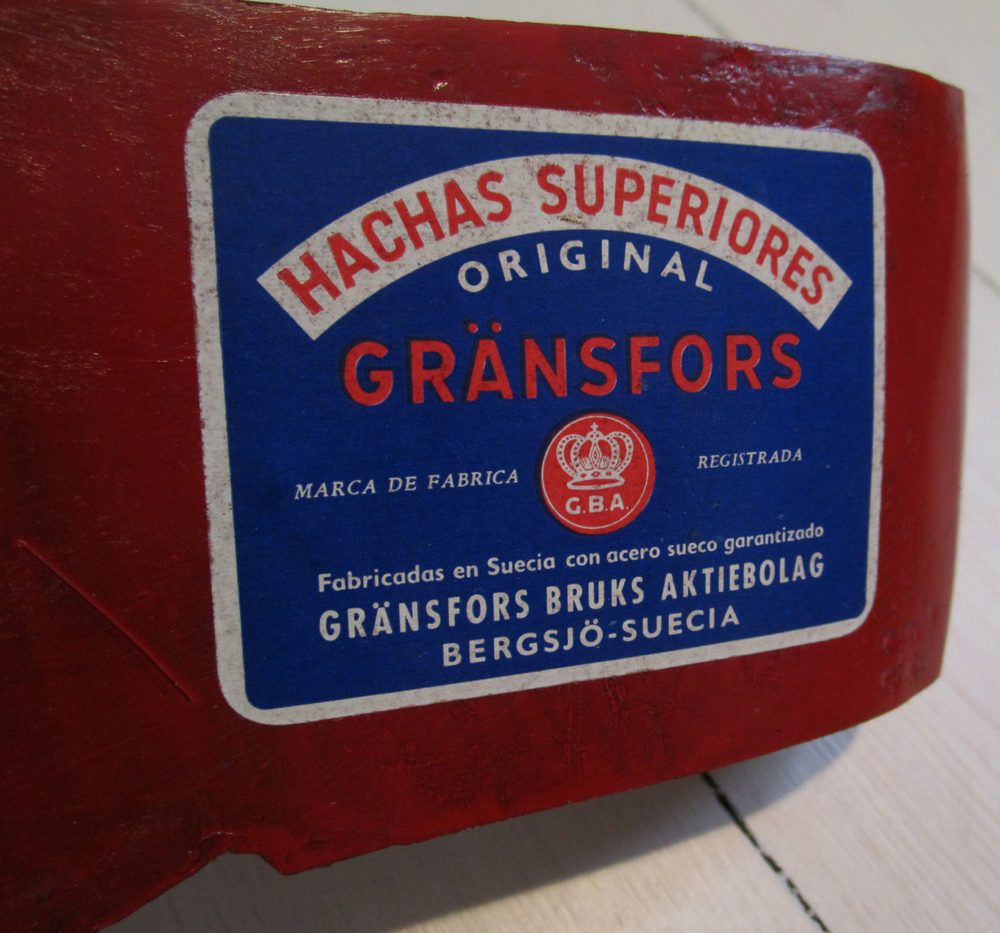
However, later that same year the company suffered a serious financial crisis. This was caused by the loss of a major customer, Strohecker & Broesamle in San Francisco, after its owner fell ill. As a consequence, several employees had to be made redundant, although a few years later the American customer’s owner recovered and business was reinstated, enabling Gränsfors Bruk to start hiring again.
When Olof Eriksson died in 1956, the helm transferred from Axel Bäckström to Olof Eriksson’s son, Torgny Eriksson. Axel Bäckström and Axel Wennerström both left the company in around 1960. Torgny was managing director and later chairman of Gränsfors Bruk until his death. He left behind seven children, including son Lars Eriksson, who had to take on the difficult challenge of leading a small family company with eight owners (seven siblings + his mother). Lars’ brother-in-law Johan Skärgård was production manager, while the chief accountant was Lars’ brother Olle Eriksson, who also worked for the family’s company Erikssons Järnhandel in Bergsjö at the same time. The fact that some members of the family worked in the company and others were only shareholders cannot have made it any easier to manage the company.
Olle Andersson, a self-taught engineering genius who kept all the production equipment up to scratch, was an important figure at Gränsfors Bruk during the 50s, 60s and into the 70s.
During the 1960s, Gränsfors Bruk produced over 200,000 axe heads per year, with major exports to the USA, Finland, Canada, Argentina and Thailand. During this time, export correspondence was dealt with by Oliny, Torgny Eriksson’s sister. Exports to Finland went through the Finnish company Stridsberg & Björk, and some years numbered over 40,000 axe heads.
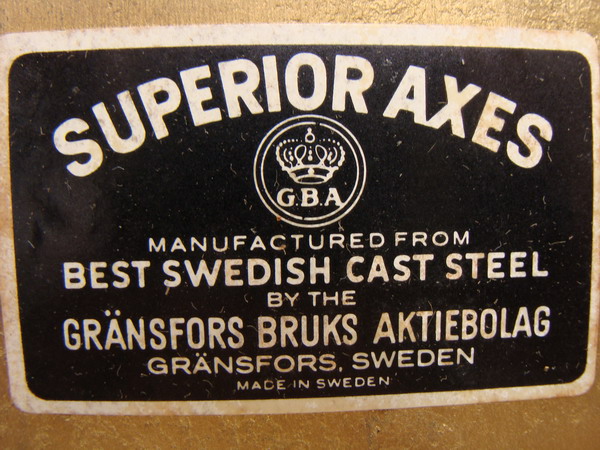
THE CHAINSAW TAKES OVER (1960 – 1982)
During the 1960s and 1970s, logging levels fell and chainsaws started being widely used for forestry work, first for felling and then also for limbing the felled tree. There were fewer forest workers and fewer people who used an axe. As a result, demand for axes in Sweden fell dramatically during the late 1960s and early 1970s. The remaining axe forges were able to survive and temporarily even increase their production on the back of competing forges closing at a time when the export of axes showed potential for growth. In 1974, Gränsfors Bruk made 200,000 axe heads, 80 percent of which went for export.
The first oil crisis in the mid-1970s caused a sudden surge in demand for axes, whose selling price rose, not least in Sweden. Producing and selling axes was once again a highly profitable business, but all the axe manufacturers in Sweden made the same strategic mistake. They focused on the profitable Swedish, Finnish and Norwegian markets, where the easiest, quickest money was to be made. 100 percent of production capacity was used, but the axe manufacturers were still unable to deliver to all their customers, and export customers on the other side of the world had to wait. Operations were rationalised as much as possible and automated grinders were brought in, simplifying both the production and the axes – often to the detriment of the axes’ quality. Gränsfors Bruk invested heavily and in 1979 built a new building over the old forging machines, but this investment became a financial burden on the company.
Once the good times of the 1970s came to an end, the whole axe industry was left with a terrible headache as demand plummeted. The chainsaw had now completely taken over in forestry and the axe customers of the oil crisis had disappeared. The Swedish industry tried selling axes back to the export customers that had been neglected for several years, but with little success. The export customers had been unable to wait, instead sourcing new axe suppliers from countries such as China, Brazil and the USA. The new competitors often had much lower prices and poorer quality compared with the Swedish products, but high-quality axes were no longer as desirable as they once were. The professional forest workers who used to use axes in their work were by now using chainsaws.
Coupled with reduced demand for axes in export countries, this led to a drop in price levels. Fewer axes were being sold at lower prices, even as the cost of axe production was rising, making a serious dent in the profits of axe manufacturers.
These were financially tough times for Gränsfors Bruk and new solutions were sought. One of these was an agreement with Finnish axe maker Fiskars, where Gränsfors Bruk would forge Fiskars-branded axe heads, which Fiskars would then sell in Finland. This brought to an end the long-standing partnership with Stridsberg & Björk in Finland. However, the new arrangement proved a mistake for Gränsfors Bruk, which lost all its sales to Finland in just a few years.
GRÄNSFORS BRUK BANKRUPT (1982– 1985)
In 1982, the Eriksson family decided to sell Gränsfors Bruks AB. The new owners and the new management team unfortunately had no interest in axe production, focusing entirely on investing in and manufacturing chain links with the help of state aid. The plan was then to sell these links to the listed company Ljusne Kätting in Söderhamn, whose customers included the offshore industry. However, things did not go quite to plan. The big new forging machine never worked properly and production never got started. In 1985, Ljusne Kätting went bankrupt, dragging Gränsfors Bruk down with it.
SVEDBRO SMIDE AB (1878 – 1940)
No history of Gränsfors Bruk is complete without tracing the roots of Svedbro Smide as well. The story of Gränsfors Bruk actually has two branches.
Svedbro Smide’s story starts in the late 19th century with a smith called Gustav Tiderman. In 1878, he established a water-powered forge in Svedbro, on the Annån river that crosses the road between Gnarp and Bergsjö, about 10 km from Gränsfors. However, the business went bankrupt after just one year and the Svedbro forge was taken over by Johan Sjölander, who ran it for about 12 years. On Johan’s death in around 1890, the forge was sold by his widow, Kajsa-Stina, to Anders Erik Bergqvist, who in turn handed the forge on to his son Erik Bergqvist in 1924. Erik was a trained smith and farrier, with a wife called Britta. Erik died in 1941 and Britta was suddenly responsible for the forge. In contrast to that other forge widow Kajsa-Stina half a century before, Britta decided to hold on to the Svedbro forge.
Britta ran the forge for six years under the name ‘Erik Bergqvist Smide Sterbhus’ with the help of smiths John Enander and Rudolf Larsson. Their products included welded high-pressure boilers and water heaters. However, a shortage of materials during the Second World War brought such production to an end. Instead, they continued to manufacture grub hoes, lifting tongs and lifting hooks.
PARTNERSHIP WITH GRÄNSFORS BRUK (1940 – 1960)
1943 saw John Enander’s nephew Per Enander, aged 22, start an apprenticeship at the Svedbro forge, which now produced a large number of contract pieces for ironmonger O Erikssons Järnhandel in Bergsjö. After a few years, Per married Britta’s only daughter and in 1947 took over the Svedbro forge, which also changed its name to Svedbro Smidesfabrik. Per continued to supply the ironmonger in Bergsjö and in 1948 also started making an older version of a wrecking bar that was sold to Gränsfors Bruk.
1951 marked the start of another partnership between Svedbro Smidesfabrik and the Stockholm-based company Skogsdon AB, with Svebro producing a number of different forestry tools for them.
In 1952, Gränsfors Bruk’s owner Torgny Eriksson, office manager Axel Bäckström and salesman Tore Vestin contacted Svedbro Smidesfabrik about them making a new wrecking bar, for which Gränsfors Bruk would provide the steel. The wrecking bars were branded TOVE after salesman Tore Vestin, and were based on an original design that Smedbro Smide had been making since 1942. However, the partnership between the two companies was not a great success, with the steel often running out and Gränsfors Bruk frequently dragging out payments to Svedbro Smidesfabrik. In 1960, Per Enander was offered the option of taking over from Axel Wennerström as forge manager at Gränsfors Bruk and at the same time selling Svedbro Smidesfabrik to Gränsfors Bruk. Per declined the offer. Instead, Per built a new forge in Gnarp with the help of Gnarp Municipality. Per and his wife Elsie worked here until their retirement in 1985.
THE SWEDISH GOVERNMENT BUYS AND SELLS (1960 – 1985)
During the 1960s, Svedbro Smidesfabrik expanded beyond wrecking bars and forestry tools to include forestry machines. In 1961, Skogsdon AB, a company whose business concept was to “develop and sell everything as a lumberjack needs”, become the minority shareholder in Svedbro Smidesfabrik. In 1971, the Swedish National Forest Enterprise, Domänverket (today Sveaskog) bought Skogsdon AB, making the Swedish state a joint owner of Svedbro Smidesfabrik. In 1978, Skogsdon bought all the shares in Svedbro Smidesfabrik and changed its name to Svedbro Smide AB. That same year, Skogsdon bought and merged with its rival Nordforest Skogstillbehör AB which had offices and warehouses in the Swedish town Säter. In connection with this, Skogsdon moved its headquarters from Stockholm and its warehouse, which since the 1960s has been located near Svedbro, also to Säter which in the eyes of the forest industry in Sweden, were more centrally located.
During the 1970 – and 1980’s, Svedbro Smide manufactured 50 or so different forestry tools alongside the wrecking bars. Sales of forestry tools, sold by Skogsdon, later Nordforest Skogsdon, however decreased as the number of active forest workers dropped due to increased mechanisation of forestry. Major products were during this time for example the tree felling tool, Stalpen and planting equipments, including a new planting tube.
In 1982, Domänverket sold Svedbro Smide to Gabriel Brånby who had previously been the CEO of Skogsdon 1977 – 1980. In 1985, Svedbro Smide bought Gränsfors Bruks AB that had just gone bankrupt, and this was the beginning of a new journey.
SVEDBRO SMIDE + GRÄNSFORS BRUK (1985 – )
In 1985, Svedbro Smide purchased the company Gränsfors Bruk. Svedbro Smide forged wrecking bars and forestry tools in Gnarp using technology that was similar to what Gränsfors had. The two businesses were merged into a single unit under the name of Gränsfors Bruks AB, but in 2005, the business was once again split into Gränsfors Bruk’s Axe Forge in Gränsfors and Gränsfors Bruk’s Wrecking Bar Forge in Gnarp.
In 1988, Gränsfors Bruk sold off its forestry tools business to Sandvik’s subsidiary Eia and concentrated more on making axes, splitting mauls, tree felling jacks, planting tubes and wrecking bars.
Some time later, the planting tube business was also sold off to Finnish company Lännen.
MORE PAINTAKING AND QUALITY-DRIVEN PRODUCTION (1988 – )
Until now Gränsfors Bruk had, like other manufacturers, focused on producing axes as quickly and cheaply as possible, often at the cost of both function and quality. The working environment was poor, the smiths were doing piecework and faults in the forging were concealed through rough grinding, rubbing, polishing and finally painting. A great deal of effort went into the post-production work and profit margins were low.
In the late 1980s, Gränsfors Bruk took a step back to a more traditional, craft-based system of production that had been the standard long ago. Knowledge about axes, their function and environmental issues became the guiding light for axe production. The restructuring was based on the insight that when you strip out everything that is unnecessary, you often get a more honest, eco-friendly and even attractive product.
The system of piecework was abandoned in favour of professional craftsmen who were allowed to take their time. The most important factor became quality, not quantity. The focus was placed on ensuring that the job of forging was done well, which removed much of the need for subsequent grinding. Also gone were all the paints, lacquers and solvents plus the epoxy adhesive previously used for attaching the handles. One by-product of this major change in production was that in 1990 Gränsfors Bruk won a prize in the Ecological Design competition organised by Svensk Form and the Swedish Society for Nature Conservation.
Despite competition among axe manufacturers remaining extremely tough in the 1980s and 1990s, Gränsfors Bruk became an increasingly sizeable player in the axe market. The company improved production and started selling in a growing number of countries. The idea of taking a step back to more painstaking and quality-driven production gradually started yielding results. Several other axe manufacturers also followed the ‘Gränsfors method’ and began producing axes in a similar vein – a clear indication that the changes were right, although the copies were sometimes ridiculously similar to the originals from Gränsfors.
FOCUS ON PRODUCT DEVELOPMENT (1990 –)
One major reason why Gränsfors Bruk has survived in the face of tough competition from chainsaws and copies is its crystal clear strategy, with a focus on product development.
Gränsfors Bruk has always kept a step ahead of its copiers and driven the development of new models. Almost all the information available on axes and axe design was studied. Old axes with different appearances and functions were analysed, practical tests were carried out with a wide range of axes and many old axe forgers and axe users were interviewed – always with a view to staying a step ahead of competitors and leading the way in axe knowledge and product development. Without the many thousands of hours spent amassing knowledge in our professional field, it would have been difficult to make the decisions on change and investment that followed.
As well as providing a solid foundation for the company, the accrued knowledge also resulted in The Axe Book, which now accompanies every axe sold by Gränsfors, and the Axe Museum, which has proved a goldmine for product development ideas. In the 1990s, Gränsfors Bruk started working with independent experts and many of the heavily copied models were quickly replaced with new models offering better design and function. None of the eight models available in 1987 were still around by 1990. The Swedish Carving Axe was produced in collaboration with craftsman Wille Sundqvist and others in 1994. In 1995, Gränsfors Bruk developed and launched the Hunter’s Axe, which was consciously made so different from other axes that the design was able to be protected under intellectual property law. The Hunter’s Axe was named an ‘Excellent Swedish Design’ in 1995. That same year is when Gränsfors Bruk started selling its axes with a 20 Year Product Guarantee. In 1996, Gränsfors Bruk launched a new range of broad axes and other tools for log-building. 1997 saw the arrival of a new, smaller Carpenter’s Axe and the earlier version, which had been copied, went out of production. By this time, eight new models had been introduced since 1990.
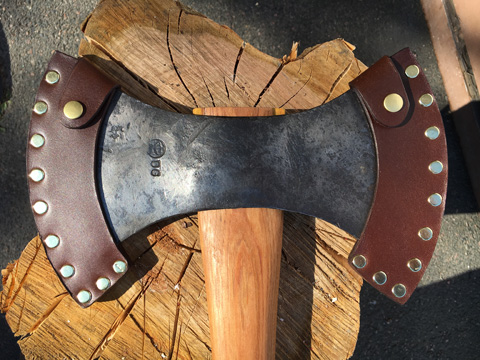
The whole range of axes for splitting wood was replaced in 1997-1998 and a brand new type of splitting axe and maul was launched, with a steel collar to protect the handle. The Swedish National Testing and Research Institute declared Gränsfors Bruk’s new Large Splitting Axe ‘Best in Test’. 1998 also marked the appearance of the American Felling Axe, developed jointly with US canoe builder and woodsman Geoffrey Burke. The Gränsfors Mini Hatchet came out in 2000 and was an instant success. A range of sharpening tools was launched in 2003, as well as the Gränsfors Small Splitting Axe. Over the period 2000-2006, various replicas of historic axes from the Iron Age and Viking Age were also developed, under the title of Ancient Northern European Axes. Now they are simply called Gränsfors Bruk’s Ancient Axes. In 2008 came the Outdoor Axe in partnership with survival expert Lars Fält. The Outdoor Axe is now protected by a patent.
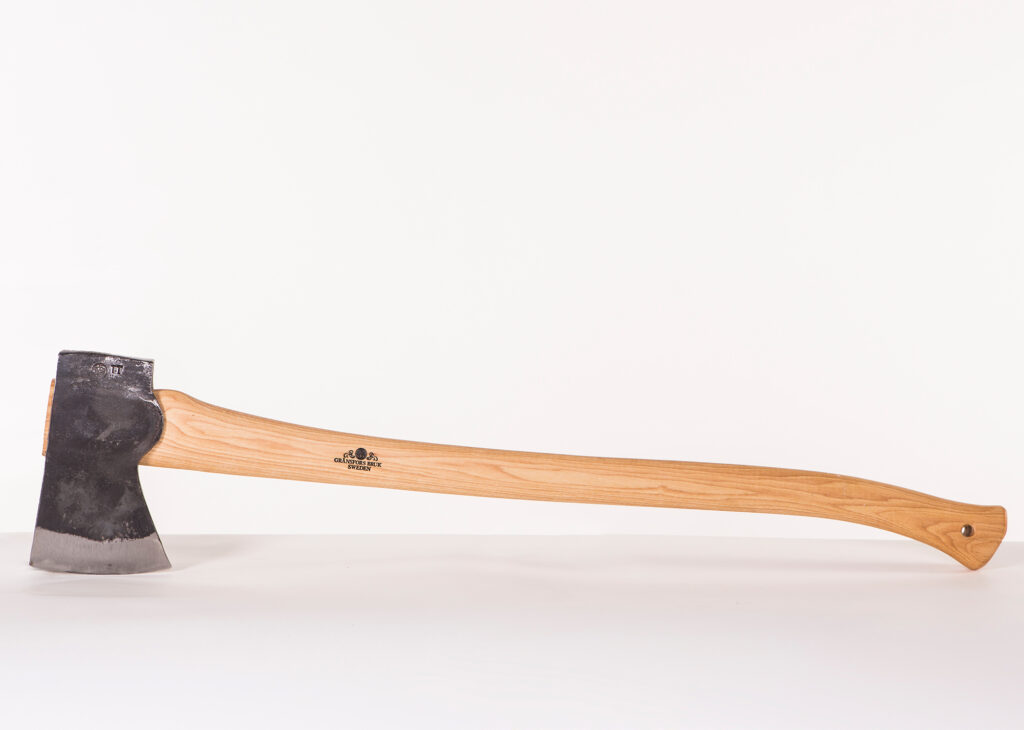
A NEW GENERATION TAKES OVER (2010 –)
Over the years, many axe forges in Sweden and around the world have closed down. As of 2013, the only forges left in Sweden were Hultafors/Hults Bruk in Åby, S.A. Wetterlings in Storvik and Gränsfors Bruk in Gränsfors. Finland has Fiskars, whose range includes axes. In Norway and Denmark there are no big axeproducers left.
Gränsfors Bruk is doing well, despite two deep financial crises over the past decade. The company has in fact strengthened its position in the axe market and gradually increased its revenues. Gränsfors Bruk’s axes are now sold in 30 countries, making it one of the leading axe producers in the world, with an extremely strong brand in its industry. Recent years have seen a gradual generational shift within the company, where two of Gabriels sons, Adam and Daniel are now leading the company.

International Shipping!
Tracking provided for all orders leaving Sweden